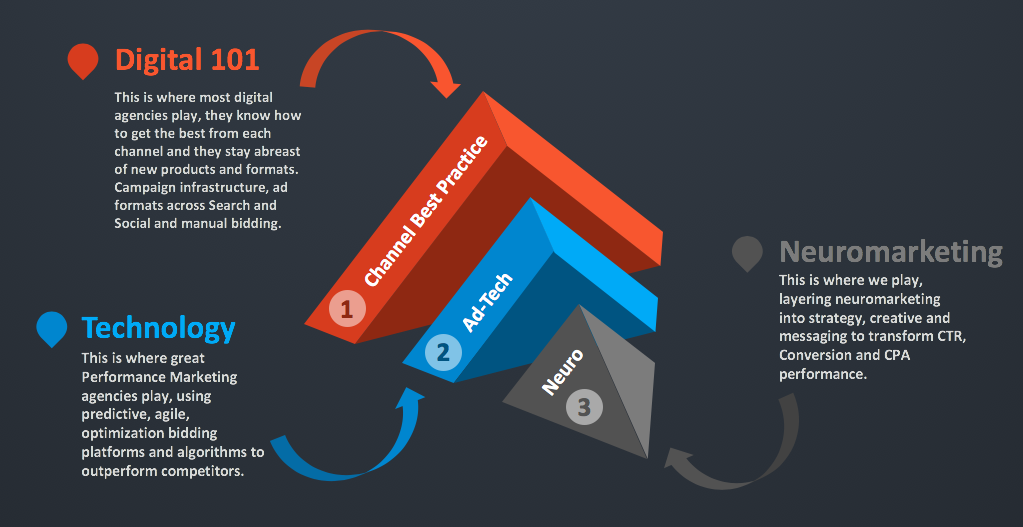Month: August 2018
Neuromarketers love customers for their brains… yum!
“Neuromarketing is that shady bollocks, ‘that Cambridge mob’ used to get Trump into power and drive Brexit through, isn’t it?”
…said my less than enthralled prospect client. I quickly moved away from telling stories about nudges and sensory language before his eyes glazed over. We didn’t end up working together, which is probably better for the both of us.
There’s absolutely no doubt that neuromarketing opens doors to consultancy contracts and wins pitches and it’s a field that is growing in mystique and more importantly, demand. Good news for Lab, good news for me!
That being said, like all superpowers, it can be used for good or it can be used for evil. Without showing too much of my geeky side, it is just like The Force… you have your Jedis, like the folks at Lab – and you have your dark side, like the folks at Cambridge Analytica. Whatever its purpose, it’s the same force, it’s the same techniques and processes, it’s the same magic – it just depends who’s wielding the lightsaber!
Let’s cut through the mystique for a second. Neuromarketing is simply about understanding how human beings make decisions. The science bit is all about brains, hearts and balls. We have techniques that help consumers make decisions that allows them to weave wonderful narratives after said decision, providing perfectly feasible logic for exactly why they made that decision!
Neuromarketing allows marketers to run highly engaging, high performing campaigns that are more cost-effective and are actually useful and welcomed by consumers. So what’s the alternative in a world where we want to spend less and achieve more with our campaigns? Run ineffective, costly campaigns that annoy consumers… sounds great.
In Roger Dooley’s brilliant book, Brainfluence, and I am paraphrasing here, he describes how most marketing departments use marketers’ brains to try and influence outcomes from campaigns. Imagine if we could use the customer’s brain to influence the outcome… that’s neuromarketing!
But it’s more than that. Yes, we are learning more and more about how the brain works, how 95% of our decisions are made by our subconscious, but we are also learning more and more about how our emotions drive our decisions. In recent studies, scientists discuss the neuro network that exists in our stomaches… feel it in your gut, literally!
I love the science, but my passion isn’t what happens in the lab or what appears in the academic journals. My passion is testing this stuff out in the channels. That’s where the ‘balls’ come in. Fail fast, fail early or even better, transform performance with a simple tweak to your campaign. I use neuromarketing as lenses for my multivariate testing methodology, it’s really that simple.
The magic, is deciding which nudges to bundle together and a deep understanding of the audience you are trying to engage and what you want them to do.
That’s how we roll in the Lab.
Neuromarketing *rolls eyes*… the new snake oil?
At the customer-end of all this incredible technology at the fingertips of today’s marketers, is the most complex of systems – the human nervous system. Even compared to AI and Robotics, we are incredible machines. We’ve mastered the art of automation and optimisation over millions of years. We don’t need to think about breathing or how complex the tendon and muscle sequence is to walk forward… we can just do it.
Neuromarketing may seem like a relatively new flavour of Kool Aid, but how humans make decisions hasn’t changed for eons. What drives us, our motives, how we can’t make a decision without emotion, how we build a logical narrative after a decision and how our decisions and actions can be manipulated (for good and for bad) is nothing new to neuroscientists, psychologists and NLP practitioners.
Neuromarketing, at least how we see it at Algorhythm, is leveraging neuro principles, psychology and behavioural economics in marketing strategy (principally around persona motivation, fears and triggers) and in campaign creative and copywriting. At its most simple, neuromarketing simply provides the lenses for multivariate testing, rather than simply writing an ad three different ways with no real methodology, neuro gives us a codex of nudges and techniques to drive actions.
For us, the magic happens out in the channels and over the last four years we have seen paid search and social campaigns dramatically outperform historical campaigns by really understanding the target audience in terms of motives, by using neuro principles in the treatment of visuals, photography and illustrations and by testing behavioural economics and nudge theory in the copy. We’ll share specific examples and case studies in time and point you in the direction of great examples we are seeing out there in channels, as and when we find them.

It does sound like secret sauce, but like all science, it’s actually methodical, has a process and really ignites when baked into the creative process. When I say creative process, I mean the research, ideation, creative and copywriting elements in campaigns. Neuromarketing should be in the DNA of the strategy, tactical and creative layers.
Clients buying neuromarketing are buying a process that is crowned with high performing campaigns and campaign assets.
When an agency top-down and bottom-up, is thinking, ideating, creating and deploying neuro principles in everything they do, it really is magical. It just makes sense and it’s because human understanding and our predictable unpredictability is at the heart of every touch point.
In the context of our consultancy, when we talk about neuromarketing, we are essentially interested in three areas.
1. Neuro principles on design, video, photography and illustration. Look at how Apple present their products, yes it’s art, but there’s science in the angles, proximity, how they show human and human emotion (usually on faces).
2. Persona Motives – this is an alternative to traditional segmentation. We still need to start with geo-demographics, as we need it for targeting, but imagine if you could define your customer’s intrinsic motives and by proxy, their greatest fears and you then crafted campaigns to use that to generate your desired actions, whether that’s a checkout, form fill or engagement.
Segmentation is a great start, but it can be deceiving.
Let me describe two men to you. Both male, British, in their 60’s, rich, love holidaying in Monte Carlo, love dogs and have lots of children. One is Prince Charles and the other is Ozzy Osbourne.
3. Behavioural Economics, Nudges and Linguistics.
Everything from confirmation bias, cognitive blindspots, social proof and anchor pricing to using sensory language, disruptive linguistics and cognitive load to create friction. I’m working on a codex of nudges that can be deployed in copy with Neuromarketing agency, Lab, so watch this space.
Every element of the above deserves its own blog post, so that’s probably the roadmap for future posts.




